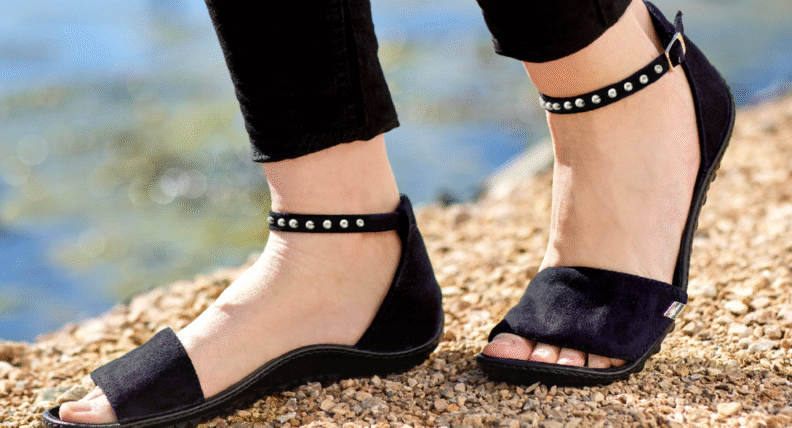If you’ve been dealing with nagging back pain, hunched shoulders, or that end-of-day ache in your knees, you might be surprised to learn your shoes could be part of the problem. Let’s explore how barefoot and minimalist footwear can reshape the way your body carries itself—from the ground up.
How your shoes mess with your foundation
Think about it: your feet are your foundation. When you wear conventional shoes with elevated heels, thick cushioning, and narrow toe boxes, you’re essentially standing on an unstable platform all day. Your body compensates by shifting your center of gravity forward, which cascades up through your ankles, knees, hips, and spine.
This forward lean forces your lower back to arch more than it should, your shoulders to round, and your head to jut forward (hello, tech neck). It’s like trying to balance a stack of books on a wobbly table—everything above has to work overtime just to keep you upright.
Barefoot shoes flip the script. With a zero-drop sole (no heel elevation) and a thin, flexible base, they allow your feet to function as nature intended. Your weight distributes evenly across your foot, your toes can spread naturally, and suddenly your entire body can stack properly without fighting gravity.
What happens when you walk naturally
Minimalist footwear promotes midfoot and forefoot strike patterns rather than the heel-pounding gait common in cushioned shoes. This shift has ripple effects throughout your kinetic chain.
When you land on your midfoot or forefoot, your ankle flexes more naturally, absorbing impact through your foot’s built-in arch system rather than sending shock waves up through rigid joints. Your knees stay more flexed at ground contact, reducing the jarring forces that contribute to knee pain. Your hips engage more efficiently, and your spine maintains its natural curves instead of compensating for imbalances below.
Over time, this natural movement pattern strengthens the intrinsic muscles of your feet—the small stabilizers that conventional shoes have been doing the work for. Six months of daily minimalist footwear use increased foot strength by 57.4%. Stronger feet mean better arch support from within, which translates to a more stable foundation for your entire posture.
Where you’ll actually feel the difference
Here’s where things get practical. That increased foot strength and improved biomechanics can genuinely reduce pain in several areas:
Back pain: When your pelvis sits in a neutral position (instead of tilting forward from elevated heels), your lower back doesn’t have to hyperextend. Many barefoot shoe wearers report less chronic lower back tension within weeks of transitioning.
Knee pain: The shift toward midfoot striking reduces the braking forces that jam through your knee with every heel strike. Your knee flexes more naturally, distributing load across muscles rather than concentrating stress on joints.
Hip discomfort: With proper foot mechanics, your hips don’t have to compensate for poor alignment below. Your glutes activate more effectively, reducing the strain on hip flexors that often tighten when wearing conventional shoes.
Neck and shoulder tension: It might seem far-fetched that shoes affect your neck, but postural alignment is a full-body affair. When your foundation improves, the tension rippling up through your spine decreases. Less compensation means less chronic muscle tension in your upper body.
The adaptation reality (it’s not instant)
Let’s be honest: switching to barefoot shoes isn’t an instant miracle cure. Your feet, ankles, and calves have likely grown weak from years of cushioned support. Suddenly asking them to do their job again is like asking a couch potato to run a marathon.
Research shows that acute use of minimalist footwear can initially reduce balance control and alter habitual gait patterns. You’ll probably notice calf soreness or tightness (your Achilles tendon is working harder), foot fatigue (those intrinsic muscles are waking up), and temporary changes in how you walk (your brain is recalibrating).
This isn’t the shoes failing you—it’s your body strengthening and adapting. The key is a gradual transition that gives your tissues time to respond. Most discomfort should be mild and productive (the “good sore” feeling), not sharp or worsening pain.
Making the switch work
Start conservatively. Wear your barefoot shoes for short periods—maybe 15-30 minutes a day for the first week or two. Gradually increase wearing time as your feet adapt.
Walk on varied surfaces: Grass, dirt paths, and softer ground are gentler starting points than concrete. Your feet learn to adapt while absorbing less impact.
Strengthen proactively: Do simple foot exercises daily—toe spreading, picking up small objects with your toes, calf raises. Building strength alongside your transition reduces injury risk.
Listen to your body: Productive muscle fatigue is normal. Sharp pain, persistent soreness, or pain that worsens is your signal to slow down.
Use a hybrid approach: Keep your conventional shoes for high-impact activities or long days initially. Gradually shift more activities to barefoot shoes as strength improves.
The payoff is worth the patience. Long-term minimalist footwear users show biomechanical adaptations that mirror natural barefoot walking, with improved foot function and no negative impact on natural movement patterns. For a complete roadmap, check out our guide on transitioning from regular shoes to barefoot shoes.
What to look for in barefoot shoes
For maximum posture benefits, your shoes should have a zero drop (completely flat from heel to toe), a wide toe box (so your toes can spread and engage for balance), a thin, flexible sole (typically 4-8mm for ground feel), and lightweight construction (reduces the effort needed for natural gait).
If you’re ready to explore, here are some excellent starting points:
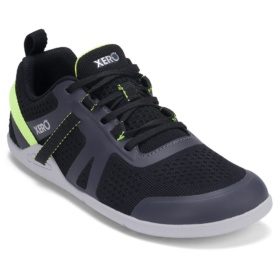
Xero Shoes Prio Neo Men Asphalt/Black
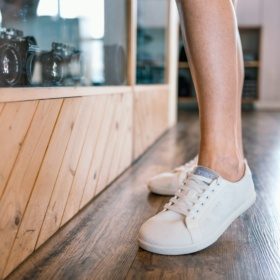
Xero Shoes Dillon Women White
The Xero Shoes collection offers particularly robust options with their 5,000-mile sole warranty, balancing minimalist features with everyday versatility.
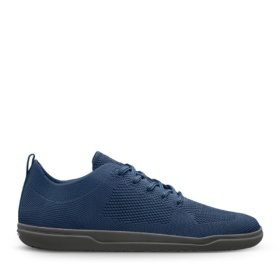
Groundies Active Knit Navy

Freet Flex
European-made options like Groundies and UK-based Freet provide excellent ground feel with flexible construction. Both brands accommodate various foot widths and offer styles for different activities.
Supporting your transition
During adaptation, some people find removable insoles helpful. They can provide temporary cushioning while your feet build strength, then be removed for full barefoot benefits.
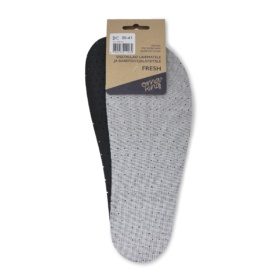
OmaKing insoles Fresh

Freet Ortholite insole
These options maintain the barefoot shoe geometry while offering extra comfort during your transition period.
Time to rethink your foundation
The connection between barefoot shoes and posture isn’t marketing hype—it’s biomechanics. When you restore natural foot function, you create the foundation for proper alignment throughout your entire body. Stronger feet, improved gait mechanics, and measurable changes in how your body moves and carries itself.
Yes, adaptation takes time and patience. But the potential payoff—reduced pain, better posture, and genuine improvements in how your body functions—makes the journey worthwhile. For more on the broader benefits, explore our article on barefoot shoes for foot health.
Ready to give your posture the foundation it deserves? Browse our collection of Leguano barefoot shoes or reach out for personalized advice on which style suits your needs. Your body—from your feet to your neck—will thank you.
